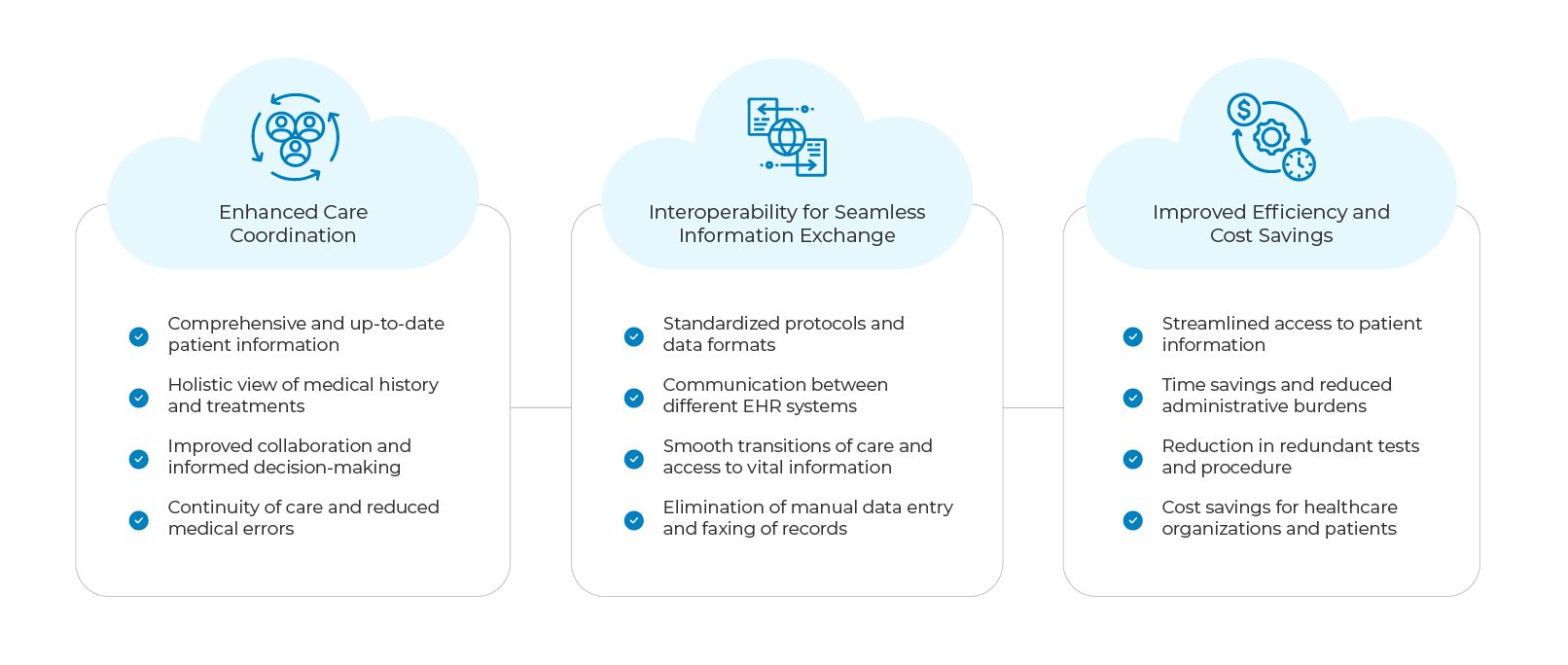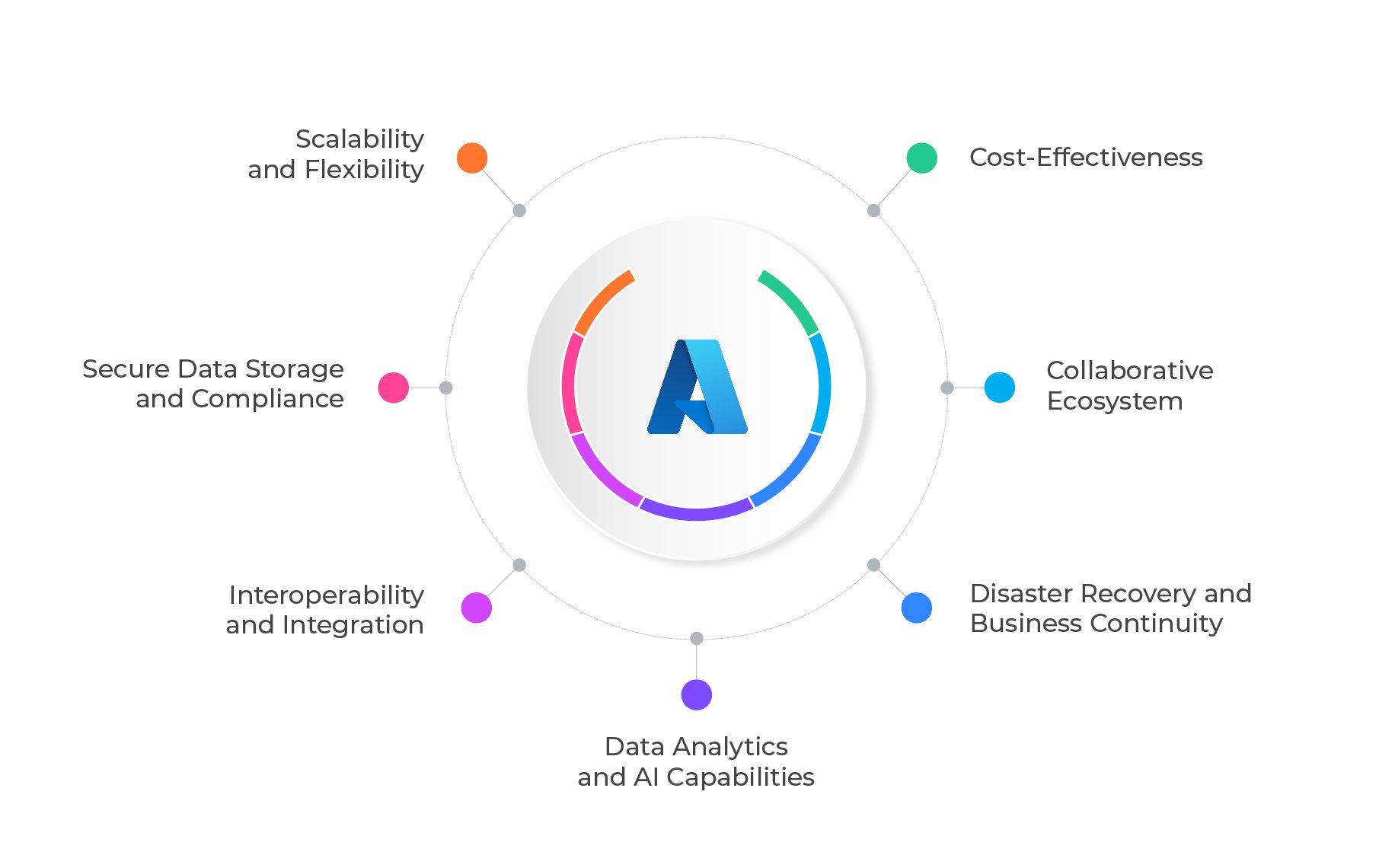Highlights:
- The healthcare sector is facing some major challenges right now, and it’s a crucial moment for the industry. The healthcare sector alone accounts for 30% of the world’s data volume, and 80% of this data is unstructured
- This flood of unmanaged and uncontrolled data is putting patient care at risk and compromising overall outcomes. It’s clear that we need a transformative breakthrough to tackle this issue. That’s where cloud-based Health Information Exchange (HIE) comes into play.
- One company that’s making a significant impact in this space is Microsoft. By bringing innovation to the forefront of healthcare, Azure is playing a vital role in accelerating the adoption of cloud-based HIE.
In this Blog
Picture this: you’re a doctor trying to provide the best care for your patient, but you’re faced with a frustrating obstacle. The patient’s medical records are scattered across various clinics, hospitals, and outdated filing cabinets. It’s like searching for a needle in a haystack. But what if there was a way to seamlessly and securely exchange patient health information between different healthcare entities? Enter cloud-based Health Information Exchange (HIE), the game-changer that revolutionizes how we share vital medical data. In this blog, we’ll embark on a journey to explore how cloud migration can foster care coordination, interoperability, and continuity of care, unlocking a new era of healthcare.
The State of Disarray: Why Healthcare Needs a Change
In this digital era, it’s astonishing to witness the healthcare industry still struggling with archaic systems, inefficient data management, and fragmented patient health information. According to RBC Capital Markets, approximately 30% of the world’s data volume is now being generated by the healthcare industry. This is expected to grow to 40% by 2025. And the worst part – 80 percent of this data is unstructured. From doctors and nurses to administrators, healthcare professionals face the daunting task of piecing together sprawls of unstructured data from disconnected sources like paper records or localized electronic health record (EHR) systems. The limitations of traditional paper records are evident, with errors, misplacement, and the challenge of accessing critical information when needed. Sadly, the adoption of individualized EHR systems by healthcare organizations only worsens the problem, creating data silos that hinder interoperability and care coordination. These limitations pose significant challenges for providers, who often spend precious time searching for patient information across multiple systems or relying on patients to provide a comprehensive medical history.
This disjointed approach leads to miscommunication, delayed diagnoses, and compromises patient safety. It’s crystal clear: the healthcare industry is in dire need of a transformative change.
The key to revolutionizing healthcare data management lies in one simple solution: a centralized, accessible, and scalable approach to healthcare data management. Imagine a world where healthcare providers, patients, and all stakeholders can access and exchange patient information effortlessly and securely. No more data silos or interoperability challenges hindering care coordination. With a centralized system in place, the puzzle pieces of healthcare seamlessly come together, ensuring continuity of care across various settings. Accessibility is a game-changer too, as healthcare providers can retrieve patient information swiftly, regardless of location or the electronic health record (EHR) system used. But that’s not all. We’re talking scalability! The volume of healthcare data is growing exponentially, and medical records are becoming more complex. A centralized, cloud-based solution steps up to the plate, offering the scalability needed to handle massive amounts of data, adapt to evolving technology, and foster future growth and innovation in healthcare. It’s time to bring healthcare data management into the 21st century. And cloud is the answer.
Enter the Cloud: Understanding Cloud-Based Health Information Exchange (HIE)
Cloud-based Health Information Exchange (HIE) is a game-changer in healthcare data management. It leverages the power of cloud computing to facilitate the seamless and secure exchange of patient health data between different healthcare organizations, systems, and providers. But what exactly does this mean for healthcare organizations?
First and foremost, cloud-based Health Information Exchange (HIE) offers a centralized and standardized platform for securely storing and accessing healthcare data. Instead of dealing with fragmented systems and data silos, healthcare organizations can connect to a unified cloud infrastructure that acts as a digital hub for patient information. This centralization empowers healthcare providers to access comprehensive and up-to-date patient records, regardless of data origin or the EHR system used. Say goodbye to time-consuming manual searches and hello to better-informed decisions and coordinated care.
Additionally, cloud-based HIE ensures a seamless exchange of patient health data. From lab results to imaging reports and medication history, healthcare organizations can securely share information in real-time. This fosters collaboration among providers, improving care transitions when patients move between hospitals or receive treatment from multiple specialists. The result? Reduced duplicate tests, enhanced care quality, and minimized medical errors.
Concerned about security? Cloud-based HIE has you covered. Cloud service providers implement advanced security protocols, encryption techniques, and access controls to protect patient information. These measures often exceed what individual healthcare organizations can provide independently. By leveraging cloud-based HIE, healthcare organizations can trust the confidentiality, integrity, and availability of patient health data.
What about scalability? Cloud-based HIE offers a significant advantage. Platforms like Microsoft Azure or Amazon Web Services (AWS) can scale resources based on demand. Whether it’s a small clinic or a large hospital network, cloud-based HIE can accommodate evolving data needs without worrying about infrastructure limitations. Efficiently manage and exchange patient health data with confidence.
The Pillars of Transformation: How Cloud-Based HIE is Revolutionizing Healthcare
Care coordination lies at the heart of Cloud-Based HIE. Imagine doctors, specialists, and pharmacists working seamlessly together, with access to comprehensive patient records in real time. This collaboration empowers healthcare professionals to make more informed decisions, eliminate redundancies, and deliver personalized care. Furthermore, interoperability becomes a reality as different systems and organizations effortlessly exchange data, breaking down the barriers that hinder seamless information flow. This paves the way for continuity of care, ensuring that patients receive consistent and connected healthcare experiences, regardless of where they seek treatment.
Cloud-Based HIE isn’t just a concept; it’s transforming healthcare as we speak. Examples of healthcare organizations that have implemented Cloud-Based Health Information Exchange (HIE) are numerous, and they showcase the tangible benefits of this transformative technology. Let’s explore some real-life examples:
- Intermountain Healthcare: Intermountain Healthcare, a not-for-profit healthcare system based in Utah, implemented a cloud-based HIE solution to enhance care coordination and improve patient outcomes. Their system, called Intermountain Connect Care Pro, allows healthcare providers to exchange patient information across different healthcare settings securely. By leveraging cloud technology, Intermountain Healthcare achieved impressive results. They reported a 36% reduction in hospital readmissions and a significant improvement in care quality.
- Indiana Health Information Exchange (IHIE): IHIE is one of the largest and most successful health information exchange organizations in the United States. They implemented a cloud-based HIE platform that enables secure patient data exchange among various Indiana healthcare providers. IHIE’s system has shown remarkable outcomes. According to their statistics, they have facilitated over 10 billion secure transactions and enabled more than 50 million clinical messages to be exchanged, leading to improved care coordination and reduced healthcare costs.
- Sutter Health: Sutter Health, a not-for-profit healthcare system in Northern California, adopted a cloud-based HIE solution to streamline data sharing and improve care coordination. By leveraging cloud technology, they were able to securely exchange patient health information across their network of hospitals, clinics, and physician practices. The implementation of cloud-based HIE resulted in a 20% decrease in hospital readmissions, demonstrating the positive impact on patient outcomes.
- Partners HealthCare: Partners HealthCare, a renowned healthcare system in Massachusetts, implemented a cloud-based HIE platform known as Partners eCare. This innovative system enables seamless data exchange and collaboration among healthcare providers, enhancing care coordination and patient safety. Through their cloud-based HIE implementation, Partners HealthCare achieved an impressive 30% reduction in duplicate testing and improved the accuracy and efficiency of medication reconciliation.
- Carequality: Carequality is an industry-driven collaborative initiative that focuses on nationwide health data sharing. By leveraging cloud-based HIE technology, Carequality connects diverse healthcare networks, EHR systems, and other health information exchange platforms, enabling seamless and secure data exchange across different regions and healthcare organizations. Carequality has facilitated the exchange of millions of patient records, improving care coordination and enhancing patient care outcomes on a national scale.
3 Ways in Which Cloud-based HIE is Helping Healthcare Organizations

The era of fragmented healthcare data is coming to an end. With Cloud-Based HIE, we have the opportunity to unlock the full potential of connected healthcare, one that can foster care coordination, enable interoperability, and ensure continuity of care for patients. It’s time to bid farewell to scattered records and welcome a future where healthcare professionals work together seamlessly, armed with comprehensive and up-to-date patient information.
Microsoft Azure: Your Partner of Choice
Microsoft Azure can be a powerful enabler for companies looking to implement cloud-based Health Information Exchange (HIE) solutions. Azure offers a wide range of services and capabilities that support the seamless and secure exchange of patient health information between different healthcare entities. Let’s explore some ways Microsoft Azure is helping companies in the healthcare industry with cloud-based HIE:

- Scalability and Flexibility: Azure provides a highly scalable and flexible infrastructure, allowing healthcare organizations to adapt their HIE systems to varying workloads and demands. Whether it’s a small clinic or a large hospital network, Azure can accommodate the needs of different healthcare entities, ensuring that they can handle data exchange efficiently, especially during peak times.
- Secure Data Storage and Compliance: Data security and compliance are critical in healthcare. Azure offers robust security features, including encryption, access controls, and threat detection, to protect sensitive patient information from unauthorized access or breaches. Azure is also compliant with various industry regulations, such as HIPAA and HITRUST, making it a trusted platform for healthcare data storage and exchange.
- Interoperability and Integration: Azure supports various data formats and standards commonly used in healthcare, facilitating interoperability between different systems and ensuring seamless data exchange. It can integrate with Electronic Health Records (EHR) systems, laboratory information systems, and other healthcare applications, streamlining the exchange of patient data between healthcare providers.
- Data Analytics and AI Capabilities: Azure’s data analytics and artificial intelligence (AI) capabilities empower healthcare organizations to derive valuable insights from patient data. By leveraging Azure’s advanced analytics tools, healthcare providers can identify trends, patterns, and potential health risks, leading to better clinical decision-making and improved patient outcomes.
- Disaster Recovery and Business Continuity: Healthcare organizations cannot afford data loss or prolonged downtime. Azure offers robust disaster recovery and backup solutions, ensuring that critical patient data is protected and available even in the face of unforeseen events. This enhances business continuity and ensures uninterrupted access to patient health information.
- Collaborative Ecosystem: Azure fosters collaboration among different stakeholders in the healthcare ecosystem. It enables secure data sharing between healthcare providers, payers, patients, and researchers, supporting a holistic approach to patient care and facilitating medical research and innovation.
- Cost-Effectiveness: Cloud-based solutions, including Azure, can be cost-effective compared to traditional on-premises infrastructure. With Azure, healthcare organizations can pay for the resources they use, allowing them to scale resources up or down based on demand, optimizing costs while maintaining top-notch performance.
Microsoft Azure presents a holistic range of services tailored to address the unique requirements of the healthcare sector, encompassing the cloud-based Health Information Exchange (HIE). Azure’s scalability, security measures, interoperability, and analytics capabilities combine forces to empower healthcare companies in embracing cloud-based HIE. This partnership enables seamless care coordination, interoperability, and uninterrupted continuity of care for patients. By joining forces with Azure, healthcare organizations position themselves at the vanguard of digital transformation, ensuring the delivery of exceptional care to patients in our increasingly interconnected world.
The Data Dynamics Advantage
The world of cloud computing is gaining great interest, but migrating your data is often the first step to taking advantage of its benefits. It is common for manual processes and budget constraints to impede cloud initiatives. To overcome these challenges, organizations need automated and scalable solutions for transferring their data to the cloud.
That’s why Microsoft has teamed up with Data Dynamics to introduce the Azure File Migration Program, a game-changer for enterprises looking to migrate their data to Azure for FREE. This collaboration allows organizations to seamlessly transfer their unstructured files and object storage data to Azure without worrying about expenses or additional migration licenses. With our automated migration process, you can reduce risks while maintaining control over access and file security, ensuring the integrity of your data.
The partnership between Microsoft and Data Dynamics goes beyond data migration. It empowers intelligent data management across On-Premise, Azure, and Hybrid Cloud environments, enhancing overall efficiency and effectiveness. Through the program, customers can register their migration projects with Data Dynamics and start moving their data to Azure right away.
But what sets Data Dynamics apart? Our platform offers a range of features to facilitate intelligent data tiering to Azure. We provide automated methods for migrating data, allowing you to migrate individual files, folders, shares, or even entire volumes from on-premises storage to Azure. With policy-based data tiering, you can create rules that automatically move data to different storage tiers based on its usage patterns, optimizing costs and ensuring that data is stored in the most appropriate tier. Data governance is another critical aspect, and our platform allows you to implement policies that enforce data security measures, such as encryption, before storing data in Azure, ensuring compliance with regulatory requirements.
The Azure File Migration Program, powered by Data Dynamics, addresses the critical challenges encountered during the cloud migration journey. It tackles issues like cost, speed, talent, and risk, helping organizations navigate the complexities and unlock the full potential of cloud computing.
To learn more about Data Dynamics and how our platform can help you achieve seamless data migration, efficient data management, and cost optimization within Azure, visit our website at www.datadynamicsinc.com. You can also reach out to us at solutions@datdyn.com or call us at (713)-491-4298 or +44-(20)-45520800. Let us be your trusted partner in your cloud migration and data management endeavors.






